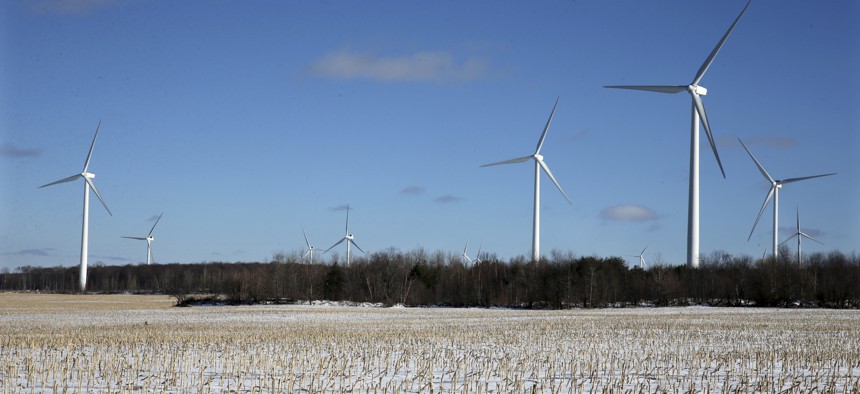
Large energy producing wind turbines that make up Noble Ellenburg Windpark are seen on a harvested cornfield on a farm Sunday, Jan. 15, 2017, in Ellenburg, N.Y. AP Photo/Mel Evans
How Green Energy Will Help Slow Nuclear Proliferation
The move to renewable energy offers the ability to delineate between ‘good’ and ‘bad’ nuclear actors in a way that we simply can’t today.
Some of the perils of reversing course on climate-change policies are obvious. Climate-induced problems such as drought, flooding, and migration worsen political instability; a burgeoning literature details how climate contributed to the Arab Spring and the Syrian civil war. Backing away from climate-related energy policies also undermines the fast-growing U.S. firms that are scrambling to catch up with green-energy manufacturers in Europe and China.
And the move to renewable energy offers another potential strategic benefit that is largely unacknowledged: the ability to delineate between “good” and “bad” nuclear actors in a way that we simply can’t today. In a world of cost-effective renewables, countries will be less able to pursue ambiguously dual-use nuclear progress under the banner of electricity generation and will be more easily enticed to relinquish more dangerous ambitions.
The line between civilian and military nuclear programs is extraordinarily thin. As Nobel laureate Hannes Alfven put it, “Atoms for peace and atoms for war are Siamese twins.” It is relatively easy for a country with an advanced civil nuclear program to move from developing power stations to their more malicious sister, nuclear weapons. With some planning, discretion, and luck, a country can easily use the fuel and by-products of light-water nuclear power reactors—enriched uranium and plutonium—to produce nuclear bombs.
This makes it difficult to ascertain the true intentions of a state developing a civilian nuclear program — or to stop it from crossing the line if and when it so chooses. Indeed, since Britain developed its atomic bomb in 1952, all nuclear aspirants have hidden their military programs behind the mask of peaceful nuclear power to one extent or another. Nuclear experts call this the “dual-use dilemma.”
We are not entirely in the dark about a nuclear aspirant’s true intentions. From enrichment activity to weaponization work, various indicators can suggest whether a nuclear program is actually for civilian or military purposes. But moving beyond hints to well-founded suspicions requires extensive intelligence-gathering efforts — and getting to certainty is all but impossible.
Lacking such certainty about political motivation — what Stanford University's Scott Sagan calls the demand side of nuclear proliferation —international nonproliferation regime has focused on reducing the supply-side risks. This includes the regulation of dual-use goods and technologies and the implementation of verification capabilities designed to identify covert nuclear weapons development. Still, no level of supply-side restriction can definitively prevent a nuclear breakout if the demand for one exists. The illicit trafficking of nuclear materials remains a persistent problem. As history has shown, for every buyer there is a seller, so long as the price is right.
But as renewable methods of energy generation — wind, solar, tidal, etc. — approach the capacity and cost-effectiveness of nuclear power, this dual-use dilemma will begin to fade away. In a world where fission generates fewer megawatts per dollar than renewable sources, the only countries that press ahead with nuclear project would be those with a niche need—such as restoring existing reactors or those with unique challenges to renewable infrastructure. The Middle East, for example, where many are most concerned about nuclear developments, is perfectly positioned for solar power, and so excuses to pursue nuclear projects would be hard to come by.
Cost-effective renewables, therefore, have the potential to provide the international community with the ability to finally delineate between “good” and “bad” nuclear actors in a way that is simply impossible today. Renewables could thus be an important component in reducing the overall risk of nuclear proliferation.
Realizing this, the U.S. has already made the promotion of non-nuclear energy a cornerstone of its nonproliferation policy: The Nuclear Non-Proliferation Act provides that the U.S. shall cooperate with other nations to help them meet their energy needs through non-nuclear technologies. A slate of innovations from airborne wind turbines and building-integrated photovoltaics to energy storage units like Tesla Powerwall and residential solar financing like SolarCity are already heralding a paradigm shift.
American leadership was instrumental in preventing the nuclear dominoes from falling. Linking continued economic and military support to nonproliferation, the U.S. made it costly for states in the sphere of its influence to go down the nuclear route. During the Cold War, nuclear cooperation programs like “Atoms for Peace” successfully served as a nonproliferation strategy, a showcase for America’s technological superiority, an instrument of public diplomacy towards allied countries, and a boon for American businesses.
Today, renewables can play a similar role. More investment in green energy would create more effective devices with lower price tags, making these technologies easier and easier to use. But if the Trump administration chooses to cede U.S. leadership in clean energy to China, Germany, and other, it will expose America to the security risks of climate change, squander the political and economic dividends paid by the surge of clean energy investments in emerging markets, and miss out on the opportunity to create thousands of well-paying green jobs at home. It will also impede progress towards what could be definitive solution to the problem of nuclear proliferation.



